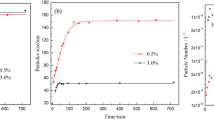Abstract
The presented paper describes a novel procedure for the preparation of inorganic nanoparticles and their surface functionalization in situ dedicated to an application in technical polymers. Using an inverse emulsion technique and amphiphilic block or statistical copolymers as stabilizers, a broad variety of nanoparticles such as ZnO, CdS, MgCO3, Ni, or Cu can be prepared. The amphiphilic polymers serve not only as surface active compounds in the emulsion but also to hydrophobize the inorganic particles as they remain adsorbed on the surface after the precipitation. As a consequence of the high degree of surface coverage by polymer chains, organic solvents are able to redisperse these particles in the aggregate free manner. The utilization of the block copolymers instead of statistical copolymers resulted in the formation of the particles, which were larger in size and possessed a much broader size distribution. The chemical nature of the adsorbed polymer layer on the particle surface is crucial to the preparation of polymer nanocomposites. The primary goal of this contribution is to demonstrate the universality of such a one-pot synthetic procedure, which was found to be relevant for industrial use.





Similar content being viewed by others
References
Roy R, Komareni S, Roy D (1984) Mater Res Soc Symp Proc 32:347–348
Wen J, Wilkes GL (1996) Chem Mater 8:1667–1681
Haas KH (2000) Adv Eng Mater 2:571–582
Judenstein P, Sanchez C (1996) J Mater Chem 6:511–525
Mulhaupt R (2004) Kunststoffe 34:76–88
Sanchez C, Lebeau B, Chaput F, Boilot JP (2003) Adv Mater 15:1969–1994
Gangopadhyay R, De A (2000) Chem Mater 12:608–622
Schottner G (2001) Chem Mater 13:3422–3435
Kickelbick G (2003) Prog Polym Sci 28:83–114
Vollath D, Szabo DV (2004) Adv Eng Mater 6:117–127
Gomez-Romero P (2001) Adv Mater 13:163–174
Huyhn WU, Peng X, Alivisatos P (1999) Adv Mater 11:923–927
Lee J, Sundar VC, Heine JR, Bawendi MG, Jensen KF (2000) Adv Mater 12:1102–1105
Alexandre M, Dubois P (2000) Mater Sci Eng 28:1–63
Pileni MP (1993) J Phys Chem 97:6961–6973
Pillai V, Kumar P, Hou MJ, Ayyub P, Shah DO (1995) Adv Coll Interface Sci 55:241–269
Nagai K (1994) Macromol Symp 84:29–36
Caseri W (2000) Macromol Rapid Commun 21:705–722
Holzinger D, Kickelbick G (2003) Chem Mater 15:4944–4948
Schmidt H (2001) Appl Organomet Chem 15:331–343
Willert M, Rothe R, Landfester KJ, Antonietti M (2001) Chem Mater 13:4681–4685
Forster S, Antonietti M (1998) Adv Mater 10:195–217
Prucker O, Ruhe J (1998) Macromolecules 31:592–601
Ginger DS, Greenham NC (1999) Synth Met 101:425–428
Wang Y, Herron N (1996) J Lumin 70:48–59
Schwerzel RE, Spahr KB, Kurmer JP, Wood VE, Jenkins JA (1998) J Phys Chem 102:5622–5626
Huyhn WU, Dittmer JJ, Libby WC, Whitting GL, Alivisatos AP (2003) 13:73-79
Pratsinis SE (1998) Prog Energy Combust Sci 24:197–219
Swihart MT (2003) Curr Opin Colloid Interface Sci 8:127–133
Mueller R, Madler L, Pratsinis SE (2003) Chem Eng Sci 58:1969–1976
Arriagadal FJ, Osseo-Asare K (1999) J Colloid Interface Sci 211:210–220
Wormuth K (2001) J Colloid Interface Sci 241:366–377
Alexandridis P, Hatton TA (1995) Colloids Surf A96:1–46
Khrenov V, Klapper M, Koch M, Mullen K (2005) Macromol Chem Phys 206:95–101
Deporter C, Long T, McGrath (1994) Polym Int 33:205–216
Butun V, Bennet CE, Vamvakaki M, Lowe AB, Billingham NC, Armes SP (1997) J Mater Chem 7:1693–1695
Bachari EM, Amor SB, Baud G, Jacquet M (2001) Mater Sci Eng B79:165–174
a) Alivisatos AP (1996) Science 271:933–937. b) Murray CB, Kagan CR, Bawendi MG (2000) Annu Rev Mater Sci 30:545–610. c) Weller H (1993) Adv Mater 5:88–95
El-Tantawy F, Abdel-Kader KM, Kaneko F, Sung YK (2004) Eur Polym J 40:415–430
Akimov IA, Denisyuk IY, Meshkov AM (2003) J Opt Technol 70:687–692
Zhang S, Horrocks AR (2003) Prog Polym Sci 28:1517–1538
Bourbigot S, Devaux E, Flambard X (2000) Polym Degrad Stab 75:397–402
Zanetti M, Camino G, Mulhaupt R (2001) Polym Degrad Stab 74:413–417
a) Faatz M, Grohn F, Wegner G (2005) Mater Sci Eng C25:153–159 b) Deelman JC (2003) Low-temperature formation of dolomite and magnesite, Compact Disc Publications, Geology series
Pu Z, Mark JE (1997) Chem Mater 9:2442–2447
Eastman JA, Phillpot SR, Choi SUS, Keblinski P (2004) Annu Rev Mater Res 34:219–246
Hindsen M (1999) Acta Dermatovenerol 204:5–22
Jerschow E, Hostynek JJ, Maibach HI (2001) Food Chem Toxicol 39:1095–1108
Hostynek JJ, Hinz RS, Lorence CR, Price M, Guy RH (1993) Crit Rev Toxicol 23:171–235
Hindsen M, Bruze M (1998) Acta Dermatovenereol 78:367–370
a) Koch M, Klapper M, Khrenov V, Mullen K, Verwendung von statistischen Copolymeren, German Patent 1002004004-209.8, 2004. b) Koch M, Klapper M, Khrenov V, Mullen K, ZnO-Nanopartikel, German Patent, 1002004004-210.1, 2004
Acknowledgement
The financial support of Merck KGaA is gratefully acknowledged.
Author information
Authors and Affiliations
Corresponding authors
Rights and permissions
About this article
Cite this article
Khrenov, V., Schwager, F., Klapper, M. et al. The formation of hydrophobic inorganic nanoparticles in the presence of amphiphilic copolymers. Colloid Polym Sci 284, 927–934 (2006). https://doi.org/10.1007/s00396-006-1468-9
Received:
Accepted:
Published:
Issue Date:
DOI: https://doi.org/10.1007/s00396-006-1468-9




